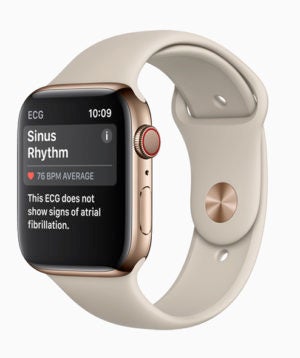Company director Andrew Marvin had to pull out of cycling coast to coast because he was experiencing palpitations and dizzy spells that puzzled his doctors.
“I wore a Holter monitor to record my heart rhythm for seven days, but it didn’t record any abnormality because I only get episodes every two to three months,” he says. “My cardiologist said that I was OK to cycle because I work out in the gym with no problems. But I didn’t feel confident to take on a three-day challenge like the 136-mile UK coast-to-coast ride.”
For Marvin, the availability of the Zio service, a small wireless patch worn on the left chest wall that records the heart rhythm continuously for two weeks, gave him the peace of mind to complete the ride this year. “The Pennines were a real challenge, but I made it,” he says.
Low-tech solutions could help catch early signs of CVD
The Zio service is one of many innovations changing the face of detection and management of cardiovascular disease (CVD). It’s a remote cardiac monitoring device to detect cardiac arrhythmias, or irregular heart rate, that may cause dizziness and palpitations, as in Marvin’s case. Zio is being evaluated by the National Institute for Health and Care Excellence (NICE), and is already used by some NHS trusts and in the private sector.
Christopher Allen, senior cardiac nurse at the British Heart Foundation (BHF), explains why detecting arrhythmias is so important. “An irregular pulse can be a sign atrial fibrillation (AF). Blood clots can form in your heart due to AF and then travel directly to the brain. Strokes caused by AF tend to be quite major strokes as the blood clots can generally be larger in size,” he says.
Leading cardiologist Dr Iqbal Malik is cautiously upbeat about a potential role for the Zio service, but says: “Low-tech solutions, such as checking the pulse and blood pressure in those most at risk, are the best way of detecting CVD in the population.”
However, for busy people like Marvin, who experience intermittent symptoms and don’t have the time or inclination to attend a clinic for an ECG, solutions like the Zio service are very attractive for making a heart healthy lifestyle easier.

AliveCor’s KardiaMobile remote ECG is compatible with most smartphones and tablets
Utilising the devices you already own
Other options include AliveCor, a medical device contained in two small patches that stick on to your mobile phone to record an ECG, and an app by Precordior that is being developed to detect AF also using your mobile phone. The app uses accelerometers, which are built into most smartphones, to detect movements of the heart using gyrocardiography technology.
Using digital technology such as ECG monitoring to detect AF is just one of many ways in which renowned cardiologist Roby Rakhit sees the landscape of CVD developing. Dr Rakhit envisages a role for tech in encouraging people to stay fit and well, and preventing premature CVD. Apps that track activity, exercise and heart rate “allow individuals to take responsibility for lifestyle intervention with potential benefits”, he says.
Vitality Health insurance has partnered with Apple, offering discounts for the Apple Watch depending on levels of recorded activity. And some of the best tools to encourage a heart healthy lifestyle are free; for example, the NHS Couch to 5K tool provides a step-by-step guide to take you from inactivity to jogging five kilometres within nine weeks.

The newly released Apple Watch Series 4 can take an ECG to detect atrial fibrillation, though it is not intended for people who have previously been diagnosed with the condition
Finding out how heart healthy you really are may come as a shock
The problem is that individuals who are most at risk of CVD, because they smoke, are overweight and don’t exercise, are least likely to engage with any of the burgeoning range of digital options that encourage a heart healthy lifestyle. The NHS is hopeful that its heart age tool might give people a jolt and shock them into action.
Mr Allen at the BHF says: “The tool is designed to give you an idea of how your lifestyle and risk factors like your cholesterol and blood pressure can impact your heart health. We’ve found that people struggled to understand how this works on a more ‘technical’ level, so giving someone a ‘heart age’ was a much more accessible way for people to have a basic understanding.”
But no matter how committed you are to leading a heart healthy lifestyle and preventing CVD, the day may come when you are diagnosed with high blood pressure, an arrhythmia or heart attack. Once the condition is stabilised and you’re out of the danger period, regular follow-up appointments can become time consuming and tedious.
Virtual clinics growing in popularity
Dr Malik says there’s a growing vogue for virtual consultations in the NHS. “It will cut out travel time for patients; young people with a single problem like palpitations will like it, but it may not suit older people with multiple problems who value the social interaction of a face-to-face consultation. And although virtual consultations save travel time for patients, it doesn’t save time for doctors.”
Doctors increasingly hold virtual clinics in which test results are reviewed and communicated to the patient, saving the need for further trips to the clinic.
And remote monitoring really comes into its own when a person needs a pacemaker or implantable cardioverter defibrillator device to control an abnormal heart rhythm or restart the heart if it stops. Remote monitoring systems are networked communication solutions that enable exchange of digitised data from an implanted or wearable device. A cardiologist can check the data and make recommendations without needing to see the person face to face.
